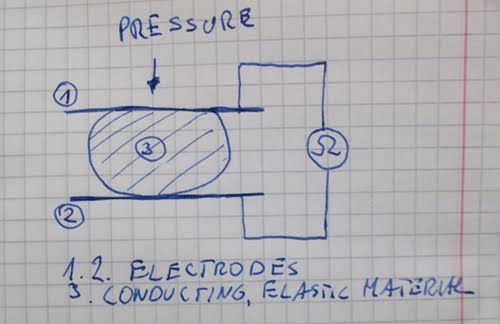Pressure sensor is an element that changes its parameters according to changes of pressure that is put on it. Today I will present how to build it by using common and cheap materials like chewing gum and pencil.


In my implementation when pressure increases, then electrical resistance of sensor decreases. Main part is elastic conductor that is in between of two electrodes connected to multimeter that indicates resistance between them. Minor role plays here elastic rubber around of conductor - it helps bring element to its original shape.

Mentioned element contains a lot of small conducting parts. When pressure increases, those elements are closer to each other, so the overall resistance of element is decreasing. When pressure goes down, element returns to its original shape and resistance.
I made experiments with two conducting elements. The first one was silicon glue mixed with graphite powder made from crunched pencil fill. Below is picture of paste made from silicon glue and graphite.

The second attempt was also with graphite powder, but instead of silicon glue I used chewing gum. Below is picture of paste made from chewing gum and graphite.

Below are couple of pictures of sensor assembled with silicon glue. Its resistance was in range 600-700 Ohms.


Here are pictures of sensor with chewing gum, its resistance was it range 600-900 Ohms.


If you would like to made this by yourself, please remember that its parameters will vary according to shape of electrodes, size of used conducting element and its materials. Those parameters will also probably change with time.
Great innovative DIY project..chewing gum concept is good, but as it loses its moisture over time, it becomes more hard..so in that case the sensor will not remain sensitive..
ReplyDeleteThanks!
DeleteYes, the sensor will lose its characteristic with the time, I think that the conception with silica gel (presented below by jawa) would solve this problem.
ya realy great innovation.. once we applied the pressure on it, the chewing gum will fasten/ pressed. even we released the pressure from it it would not return to normal state. still chewing gum will fasten. instead of chewing gum silica gel is best i think. and one thing i want to knew what are that 2no's of blak rods @ both side, what it is?
ReplyDeleteThanks!
DeleteThe black pieces are a heat-shrink tubings, they balance the pressure made on the sensor and will bring the sensor to its original shape after the tension stops.
But how do you calibrate this, how do you convert the ohms to force.
ReplyDeleteIt was made a long time ago more to check if such way would be possible than to use it in real world application.
DeleteHowever a calibration would be possible, one would have to build it, measure resistance, then place 1kg weight, measure resistance, add another 1kg, measure again and so on. As 1kg could be used also 1l of water. Then use linear interpolation on the data to measure unknown mass.
In this scenario, mass can be translated to pressure:
P = F/A = (m*g)/A
https://en.wikipedia.org/wiki/Surface_pressure
I don't know if it's 100% correct, but the general idea should be as this I think.
Nice concept and ya i think silica gel is better since gum wont stay moisture all the time.
ReplyDeleteNice work!
Hi,
Deletethanks, probably yes, but it was just a prove of concept that this can be possible.
Bob
Bob.